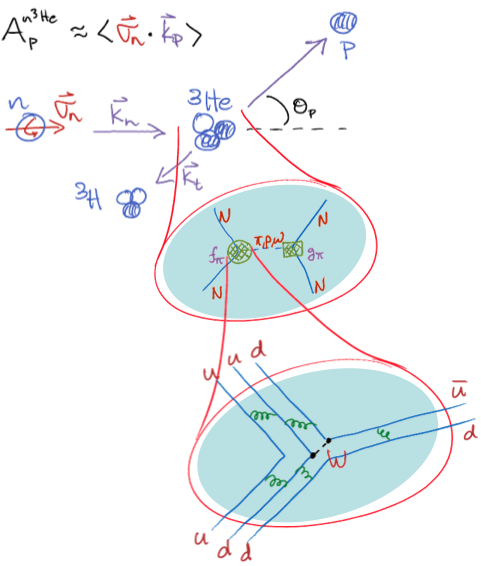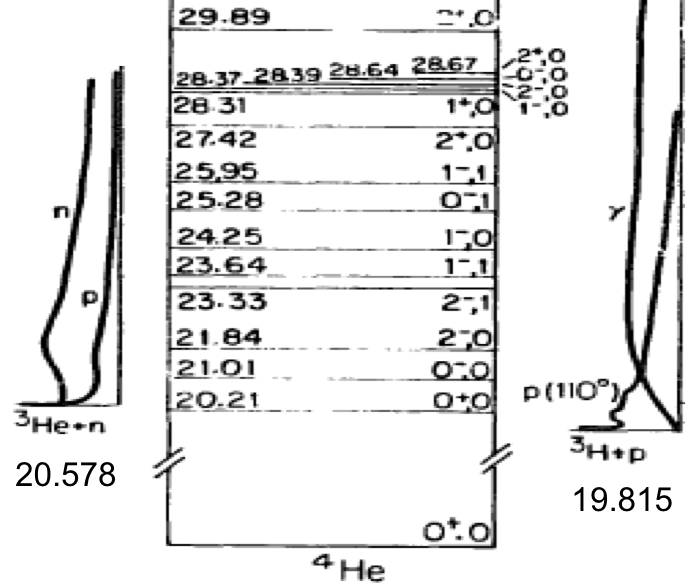The n-3He Experiment at SNS
Introduction
The n-3He experiment is a high-precision measurement of the hadronic weak interaction (HWI) via the reaction n + 3He -> p + T + 765 keV. The correlation between the spin of incident cold neutron and the momentum of the resultant proton has a handedness and thus breaks the symmetry of mirror reflections. From the standard model, this is a clear signature of the weak force buried in a process that is dominated by the strong force. Filtering on this unambiguous signature of the weak interaction, we can gain sensitivity to effects 107 times smaller than the standard interaction.
The n-3He experiment will be performed at the Fundamental Neutron Physics Beamline (FnPB) at the Spallation Neutron Source (SNS) at Oak Ridge National Laboratory (ORNL) in Tennessee. The experiment is scheduled to be installed on the beamline during the summer of 2014, and will be commissioned during the rest of 2014. We will take physics data for two beam cycles during the entire calendar year 2015. Our goal is to measure an asymmetry in the reaction to a precision of 1.6 x 10-8, which we expect to be a relative uncertainty of 15%. This will be the lowest relative uncertainty measured in any few-body hadronic weak reaction.
Hadronic Weak Interaction (HWI)

This experiment is part of a general program to characterize the weak force in nuclear reactions. In various models, this Hadronic Weak Interaction (HWI) is characterized by 6 different couplings representing different quantum states of the initial and final protons and neutrons, which interact to form the nuclear reaction
In the DDH scheme, the couplings are:
a) f_pi the long range coupling
b) h_rho^0,1,2 for the heavy meson \rho^+,-,0
c) h_omega^0,1 for the heavy meson \omega^0
In effective field theories, the couplings b) and c) are replaced by contact interactions with appropriate operators.
In turn, these couplings are the result of sub-microscopic interactions between quarks and gluons within the proton and neutron. The weak nature comes from the weak W and Z vector exchange bosons, which are intrinsically left-handed. This handedness is ultimately responsible for parity violation (broken mirror symmetry) in these reactions.
The n-3He Reaction

The energy levels of the 2-proton, 2-neutron system are shown on the right. The neutron captures on 3He to for an excited 4He intermediate state about 20.6 MeV above the tightly bound ground state (alpha particle). However the 0+ resonance at 20.21 MeV has the same parity and angular momentum as the ground state, which forbids decay by a gamma transition. Instead, it breaks up into a proton and triton. The proton carries 3/4 of the energy and leaves an ion trail about 5 times longer than the heavier triton. This difference allows us to measure the correlation of the proton direction with the incoming spin of the neutron.
Parity violation is manifest in the mixing of the two lowest excited states, which are parity even and odd, respectively. The isospin I=0 nature of these excited states makes the reaction particularly sensitive to the isospin I=0 couplings h_rho^0 and h_omega^1. However, these states carry no angular momentum, so mixing with other resonances is necessary for spin dependence of the reaction, and this introduces a large dependence on the I=1 long range coupling f_pi.
Probing The Hadronic Weak Interaction